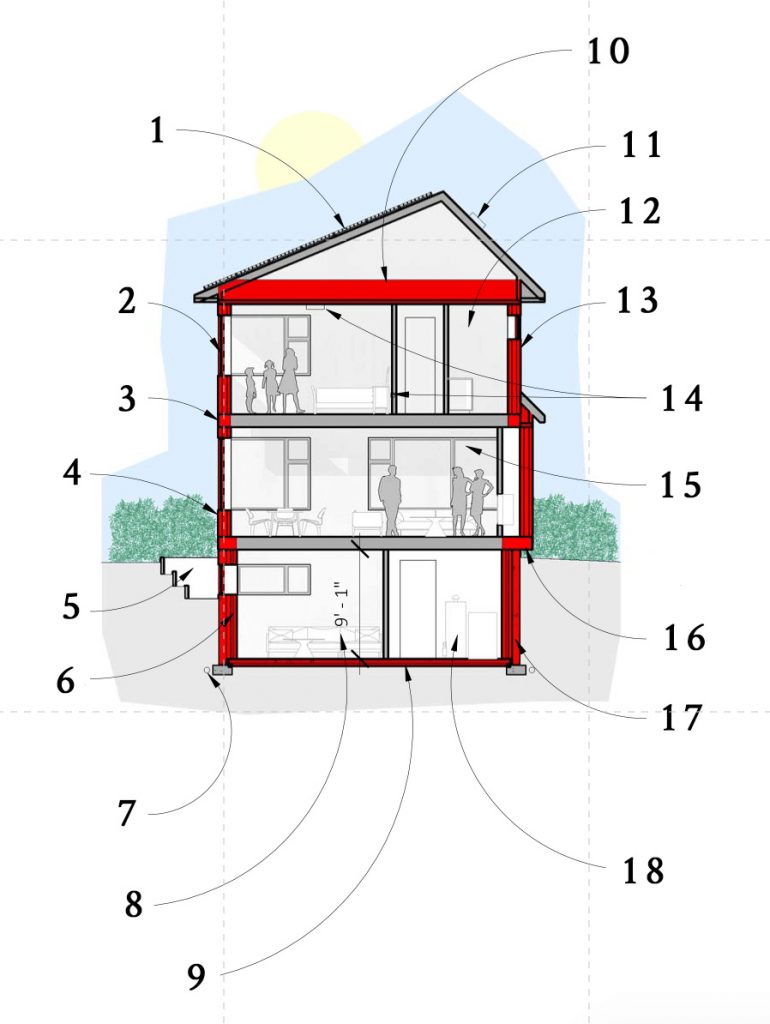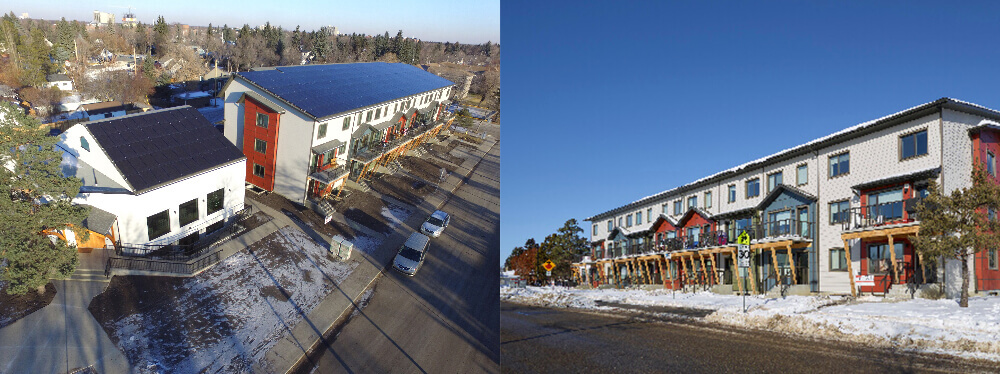We are national leaders in sustainable home building.
Our first priority is building you a great place to live, but we do so with an energy conscious mindset. We are consistently monitoring the newest construction and sustainability technologies and wherever possible we implement these advancements to make improvements in our homes and building processes.
Green Builder in Edmonton
We are an award-winning, nationally recognized expert in sustainable building. With decades of commitment to energy efficiency and training in the Passive House system, we are a leading North American authority on net-zero energy design and construction. Since completing our first award winning net-zero home in Edmonton’s Riverdale district in 2009 we have completed ten net-zero homes and our first net-zero retrofit project. With Habitat’s own ‘minimal requirements’ in energy efficient building practices, it is already much higher than the industry requires.
We want to make sure that your Habitat Studio home is something that you can boast about!
Sustainable Design – The Way We Build

Sustainable Design – The Way We Build
- Roof trusses designed for future solar panels
- Triple glaze windows (argon filled with 2 lowE coatings) sealed tight with spray foam
- Well insulated and sealed rim joists keeps cool air out
- Breathable exterior and proper drainage with rain-screen behind every exterior finish
- Wood timber window wells
- Cozy basement frost wall insulation from R30 to R40 and higher (code requires min. R18)
- Weeping tile and waterproofing keeps dampness away
- A true 9’-1” basement ceiling height
- Toes stay warm with insulation under the basement slab to R20 and higher (code doesn’t require any insulation) and a radon gas barrier keeping your home protected
- Attic insulation levels from R60 to R100 and higher (code requires min. R50)
- Consistent and continuous attic ventilation
- Bath fans not required due to the high efficiency HRV system
- Exterior wall insulation levels from R28 to R40 and higher (code requires min. R24)
- Ceiling lighting and electrical outlets are air tight and not susceptible to drafts
- Energy analysis and blower door test ensure an air tightness of 1 air exchange per hour or less, with some below 0.5 (code requires max. 2.5 air exchanges per hour)
- No cold spots at cantilevers because they are well insulated and heated
- A stronger, long lasting, reinforced foundation wall that doesn’t crack and is engineered well beyond building code requirements
- Minimum 97% high efficiency direct vent mechanical systems and a reversible electrical meter.
Highlighted Projects
⏐ Riverdale Net-Zero Project, the first net-zero home in Northern Alberta
⏐ Mill Creek Net-Zero Project
⏐ First Net-Zero Church in Canada in conjunction with a Net-Zero townhouse project
⏐ Belgravia Net-Zero Project, the first home in Canada to produce a measured 40% energy surplus, two years running
⏐ Parkland Net Zero Project, the first certified LEED Platinum home in Northern Alberta
⏐ Built the first NRCan R-2000 Net-Zero Energy Pilot house in Canada
⏐ The ‘NetZero SweetSpot’ Project was the first house in Canada to receive the official Net Zero label and first to receive an EnerGuide label of zero on the new EnerGuide rating system
Below are some images of one of our highlighted projects: The First Net-Zero Church in Canada in conjunction with a Net-Zero townhouse project.

Awards and recognition
⏐ 2022 Environmental Recognition Award (Canadian Home Builders’ Association)
⏐ 2021 Environmental Recognition Award (Canadian Home Builders’ Association)
⏐ 2020 Environmental Recognition Award (Canadian Home Builders’ Association)
⏐ 2019 Environmental Recognition Award (Canadian Home Builders’ Association)
⏐ 2018 Environmental Recognition Award (Canadian Home Builders’ Association)
⏐ 2017 Environmental Recognition Award (Canadian Home Builders’ Association)
⏐ 2016 Environmental Recognition Award (Canadian Home Builders’ Association)
⏐ 2015 Environmental Recognition Award (Canadian Home Builders’ Association)
⏐ 2014 Environmental Certificate of Recognition (Canadian Home Builders’ Association)
⏐ 2013 Environmental Certificate of Recognition (Canadian Home Builders’ Association)
⏐ 2013 Green Builder Challenge Award from the Alberta Chapter of the Canada Green Building Council
⏐ 2012 Environmental Certificate of Recognition (Canadian Home Builders’ Association)
⏐ 2011 Product of the Year in Canada for our PV awning system (Net-Zero Energy Home Coalition)
⏐ 2011 Canadian Champion of the Year, Peter Amerongen (Net-Zero Energy Home Coalition)
⏐ 2011 LEED Platinum rating (for one Parkland NetZero, first in Northern Alberta)
⏐ 2009 Closest to Net-Zero Custom Home Builder of the Year in Canada (Net-Zero Energy Home Coalition)
Please see our awards section for an archive of our industry awards and recognition for sustainable building.
Below are some images of our PV awning system which won the 2011 Product of the Year in Canada with the Net-Zero Energy Home Coalition.

Sustainable Resources
We recommend the following online resources for industry information about sustainable building practices and net-zero construction:
National Resources Canada (NRCan) Office of Energy Efficiency (OEE) – Rock-solid information about general energy efficiency for houses and appliances.
Green Building Advisor – Practical information about advanced energy efficiency. Written from a builder’s perspective and includes informative discussions.
Building Science Corporation – Easy-to-read reports that cover the latest research on building science. A good source of information about energy-saving details that also enhance durability.
Net Zero Energy Home Coalition – Information about net-zero energy housing. Has excellent webinars, including a few by Habitat’s Peter Amerongen.
Passive Buildings Canada – Information about Passive Houses, the highest standard for energy-efficient building in the world. See also Passive House Institute US (PHIUS).
Passive House Canada – National non-profit association advocating for the Passive House high-performance building standard. Passive House is recognized internationally as the proven best way to build for comfort, affordability and energy efficiency of residential, institutional and commercial buildings, through all stages of design, construction, and livability.
Solar Alberta – Great source of information about local renewable energy activities and initiatives with a library of good presentations, including a few by Habitat Studio’s Peter Amerongen.
Green Edmonton – An online portal offering local sustainable lifestyle and consumer solutions for Edmontonians. Good information on Habitat Studio’s Mill Creek Net-Zero Project.
City of Edmonton Green Home Guide – Great source of information from the City of Edmonton about sustainable building practices.
For more information about sustainable home building, contact us to talk to an expert.
